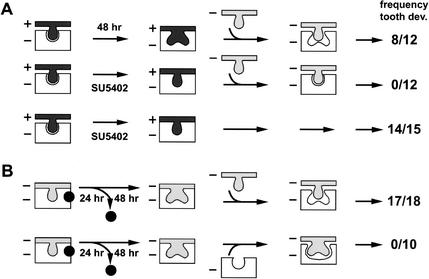Figure 3.
Epithelial-to-mesenchyme FGF signaling. (A) Inhibition of tooth development by the FGF signaling antagonist SU5402. Frequency of tooth development (dev.) in epithelium–mesenchyme double combinations from wt (+) and Lef1−/− (−) tooth germs. (Top panel) Transient (48 h) exposure of Lef1-deficient mesenchyme (white) to wt dental epithelium (dark gray) allows tooth development after its subsequent recombination with mutant epithelium (light gray). (Middle panel) The presence of 25 μM SU5402 during the transient presence of wt epithelium prevents subsequent tooth development under otherwise identical conditions. (Bottom panel) Control experiment indicating that 48 h of exposure to SU5402 per se does not impair subsequent tooth development. The arrest in tooth development is represented by a bud structure of the epithelium. (B) FGF4 acts on the mesenchyme. Lef1−/− tooth germs were incubated with FGF4 beads for 24 h and after a further 48 h incubation without beads, the mutant mesenchyme (top panel) or the mutant epithelium (bottom panel) were exchanged with corresponding fresh mutant tissues (light gray). High frequency (17/18) of tooth development is observed with mutant mesenchyme, but not with mutant epithelium that had been exposed to FGF4.

